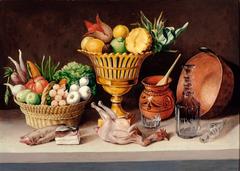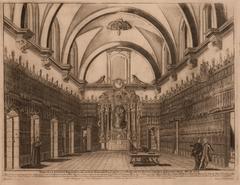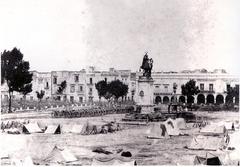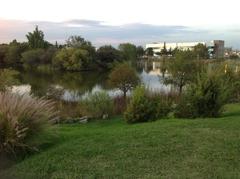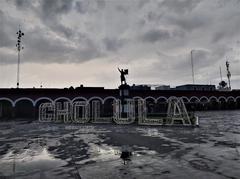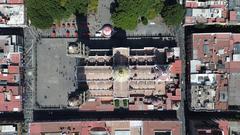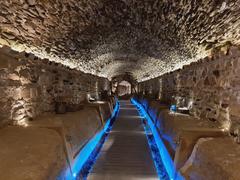
San Pedro Art Museum Puebla, Mexico: Visiting Hours, Tickets, and Travel Guide
Date: 03/07/2025
Introduction
Immerse yourself in Puebla’s rich heritage at the San Pedro Art Museum (Museo de Arte de San Pedro), a landmark where colonial architecture and dynamic cultural programming intersect. Set in a grand 16th-century building originally constructed as the Hospital de San Pedro, the museum stands as a symbol of the city’s evolving identity—from a center of colonial medicine to a hub of contemporary creativity. Whether you’re an art aficionado, a history enthusiast, or a curious traveler, the San Pedro Art Museum promises a rewarding journey through centuries of artistic and architectural achievement (Lonely Planet; Discover Puebla; 33travels.com).
This comprehensive guide details everything you need to plan your visit, including museum history and significance, architectural highlights, collections and exhibitions, practical visitor information, and nearby attractions.
Contents
- Historical Background and Transformation
- Architectural Features and Preservation
- Museum Collections and Exhibitions
- Visitor Information: Hours, Tickets, and Accessibility
- Museum Layout and Facilities
- Travel Tips and Nearby Attractions
- FAQs
- Conclusion
- Official Sources
Historical Background and Transformation
From Hospital to Museum
Originally established in 1544, the building housing the San Pedro Art Museum began as the Hospital de San Pedro, one of colonial Mexico’s earliest and most important medical institutions. The hospital served the city’s poor, sick, and travelers for centuries, its mission rooted in the charitable and religious aims of the Spanish colonial regime. Architectural highlights from this period include Renaissance and early Baroque elements—thick stone walls, vaulted ceilings, and a central courtyard—which still define the site’s character (Lonely Planet).
As Puebla modernized, the building adapted to new purposes, serving as a tram depot, stable, wrestling arena, and eventually offices for the State General Archive. Despite these changes, many original architectural features were preserved (Discover Puebla).
At the turn of the 21st century, recognizing the building’s historical value, local authorities launched a comprehensive restoration. In 1999, the site was inaugurated as a museum dedicated to the arts, first as Museo Poblano de Arte Virreinal, and soon after, the Museo de Arte de San Pedro. This transformation marked the building’s shift from healing the body to nurturing the spirit (WhichMuseum; 33travels.com).
Architectural Features and Preservation
The museum is celebrated for its successful blend of preservation and adaptive reuse. Key historic elements—stone columns, vaulted ceilings, and the iconic central courtyard—remain intact. Modern interventions, such as ramps and elevators, ensure accessibility without compromising the building’s integrity. The structure’s layered history is visible throughout, with traces of its medical, civic, and cultural past woven into the fabric of each gallery (Discover Puebla).
Museum Collections and Exhibitions
Permanent Collection
The San Pedro Art Museum’s collection spans colonial to contemporary periods, giving visitors a sweeping view of Puebla’s artistic evolution:
- Colonial Art: Includes religious paintings, altarpieces, and Talavera ceramics reflecting Puebla’s role as a colonial artistic center. Notable artists such as Cristóbal de Villalpando and Juan Tinoco are represented.
- 19th and 20th Century Art: Features academic portraiture, works influenced by Mexican muralism, and early photography documenting Puebla’s landscapes.
- Contemporary Art: Showcases paintings, sculptures, installations, and new media by current Mexican and international artists, emphasizing the ongoing vitality of Puebla’s art scene.
- Sacred Art: A dedicated gallery preserves religious works under the stewardship of the State Government of Puebla (Hotel San Angel).
Temporary Exhibitions and Special Projects
The museum’s temporary exhibitions rotate throughout the year, featuring both established and emerging artists. Recent shows have explored Baroque art, women in Mexican art, and international collaborations. Site-specific installations, courtyard sculptures, and educational exhibits add variety and encourage repeat visits. The museum also showcases student and community art, fostering local engagement (33travels.com).
Apothecary Exhibit
A unique highlight is the recreated apothecary, offering a glimpse into the building’s medical past with dioramas and explanatory panels.
Visitor Information: Hours, Tickets, and Accessibility
- Location: 14 Poniente Street (sometimes listed as Calle 4 Norte 203), Historic Center, Puebla, Mexico (WhichMuseum)
- Hours: Tuesday–Sunday, 10:00 AM–6:00 PM. Closed Mondays and major holidays (Discover Puebla)
- Tickets: General admission 50 MXN; discounts for students, seniors, and children; free on Sundays
- Tickets Purchase: At the entrance or online
- Accessibility: Ramps, elevators, and accessible restrooms throughout
- Languages: Most displays in Spanish; some English explanations; English-speaking guides available by advance request
Visitor Tips:
- For a quieter visit, come on weekday mornings.
- Take advantage of free admission on Sundays.
- Use translation apps if you’re a non-Spanish speaker.
- Allow at least 1–2 hours for your visit.
Museum Layout and Facilities
- Central Courtyard: Used for sculpture displays and cultural events.
- Permanent and Temporary Galleries: Organized around the courtyard, with ground-floor permanent exhibits and upper-level temporary shows.
- Auditorium & Multipurpose Rooms: Host concerts, lectures, and workshops.
- Educational Spaces: Support school and community programs.
- Amenities: Café, gift shop, restrooms, Wi-Fi, and a cloakroom.
Travel Tips and Nearby Attractions
- Getting There: Centrally located; accessible by bus, taxi, or walking. Limited street parking available.
- Nearby Sights:
- Cathedral of Puebla: Magnificent Baroque structure just steps away.
- Biblioteca Palafoxiana: UNESCO-listed, oldest public library in the Americas.
- Museo Amparo: Renowned art museum blending pre-Hispanic and modern art.
- Calle de los Sapos: Famous for antiques, crafts, and weekend markets.
- El Parian Market: Ideal for local souvenirs and street food.
FAQs
Q: What are the San Pedro Art Museum visiting hours?
A: Tuesday to Sunday, 10:00 AM–6:00 PM; closed Mondays.
Q: How much are tickets?
A: 50 MXN general admission; discounts for students/seniors/children; free on Sundays.
Q: Is the museum wheelchair accessible?
A: Yes—ramps, elevators, and adapted restrooms are available.
Q: Are guided tours available in English?
A: Yes, with advance reservation.
Q: Can I take photos inside?
A: Photography is allowed except during certain temporary exhibitions.
Q: How long should I plan for my visit?
A: 1–2 hours is ideal for most visitors.
Conclusion
The San Pedro Art Museum stands as a cornerstone of Puebla’s cultural and historical landscape. Its thoughtfully curated collections, dynamic exhibitions, accessible facilities, and vibrant programming make it a must-visit for anyone exploring Puebla. Located within the city’s UNESCO-listed historic center and surrounded by other notable sites, the museum is perfectly positioned for a full day of cultural discovery.
For up-to-date information on exhibitions, visiting hours, and events, visit the official museum website. Enhance your visit by downloading the Audiala app for personalized tips, guided tours, and real-time updates on Puebla’s cultural scene.

